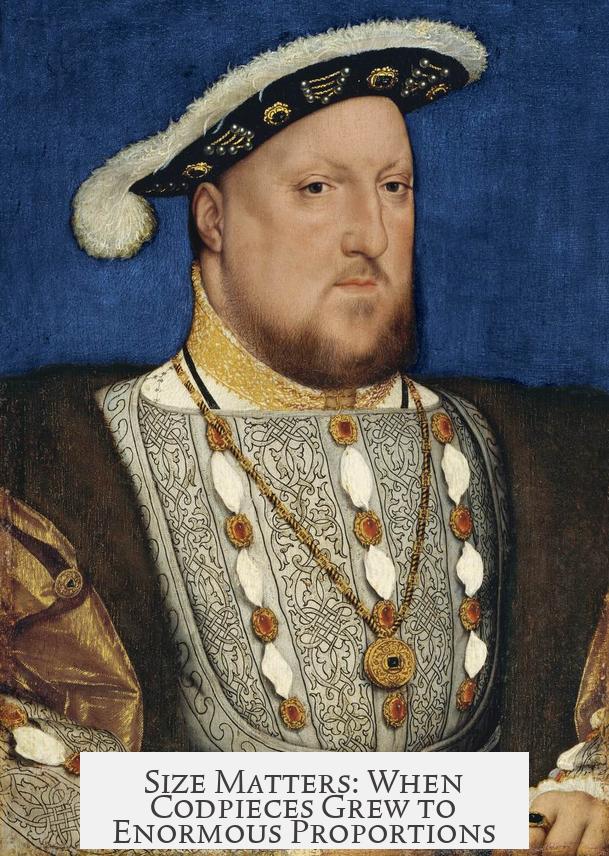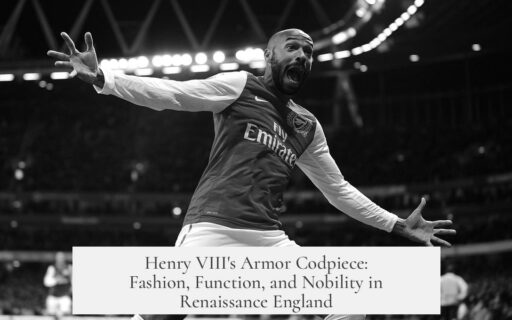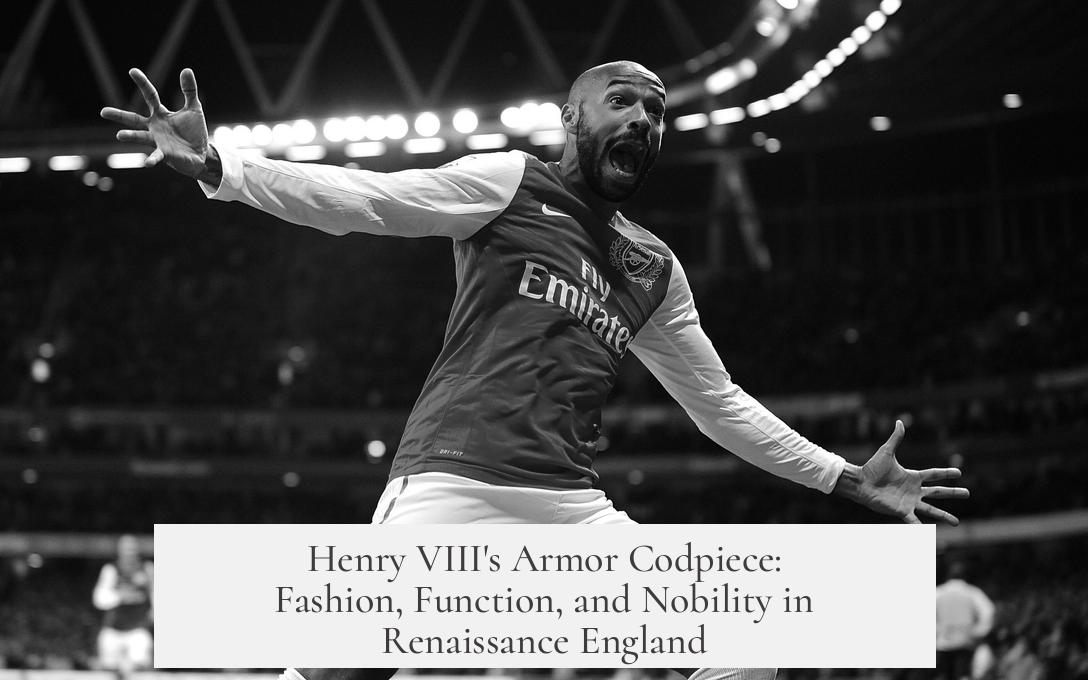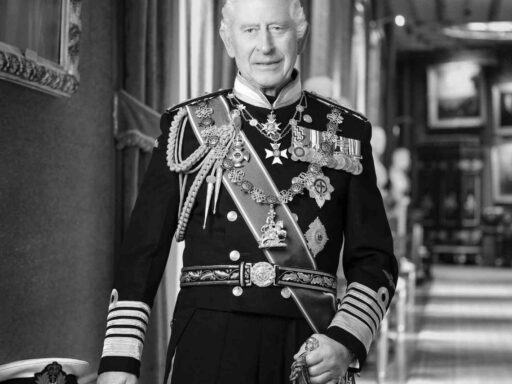Henry VIII’s armor features an unusually large and extended groin area, known as a codpiece, which served both practical and symbolic purposes. This exaggerated codpiece style was common among the nobility during his reign and reflected fashion, status, and masculinity.
Originally, codpieces started as simple cloth coverings to protect and conceal the genitals. As doublets—the close-fitting jackets worn at the time—were cut higher, this area became exposed. The codpiece thus evolved to cover that gap securely. Over time, it became more than just functional.
By the 16th century, especially during Henry VIII’s reign (1509–1547), codpieces were enlarged and decorated. They symbolized virility and power. Nobles and wealthy men used large codpieces to draw attention to their masculinity and status. This trend reflected broader Renaissance ideals that celebrated physicality and dominance.
Henry VIII’s armor codpiece was made of metal and deliberately oversized, underscoring his image as a powerful and commanding monarch. Unlike common soldiers, the king’s armor was designed to impress as much as to protect. His codpiece visually emphasized strength and royal authority.
This fashion was widely adopted by the aristocracy and high-status men. In fact, large codpieces remained popular through the Tudor period and only declined near the end of Elizabeth I’s reign. The exaggerated size became less practical and more symbolic over time.
| Period | Use of Codpiece | Significance |
|---|---|---|
| Early 16th Century | Simple cloth covering | Protection and modesty |
| Henry VIII’s Reign | Large, ornamental metal codpieces | Display of virility and status |
| Late Tudor Period | Declining size | Changing fashions and practicality |
- Codpieces began as protective garment components.
- Henry VIII popularized exaggerated, metal codpieces in armor.
- Large codpieces symbolized masculinity and power.
- The fashion was common among nobles in Tudor England.
- Such styles faded out by late Elizabethan times.
Why Was Henry VIII’s Groin Area in His Armor So… Large and Extended? Was This Common in Those Times?

Answering the big question upfront: Henry VIII’s groin area in his armor was so large and extended because of an exaggerated codpiece, a fashion trend that peaked during his reign. This was not just about protection; it was a bold statement of status, virility, and power — very much in vogue among the nobility.
Now, let’s break this down with detail and a touch of wit. The enlarged codpiece you might have noticed in images or armor displays is a fascinating cultural artifact, not a random design choice or a medieval plumbing solution! It is a crucial piece that blends function, fashion, and theatrical flair.
From Practical Cloth to Fashion Statement
Originally, the codpiece was just a simple cloth flap used to cover and protect a man’s nether regions. As men’s doublets—the snug jackets they wore—started to get shorter and higher waists became trendy, the groin area was left exposed. Imagine a serious wardrobe malfunction if you will! To address this, a piece of fabric was stitched onto the front, covering and shielding that vulnerable zone.
However, this modest patch quickly evolved beyond basic protection. No longer just a practical fix, the codpiece became a canvas of masculinity. Men began to emphasize it, turning what was once a discreet flap into a feature that screamed, “Here lies a man of importance!”
Henry VIII and the Peak of Codpiece Prominence
During Henry VIII’s reign in the early to mid-1500s, the codpiece really hit its stride. The king was known for grand displays of wealth and virility, and his armor’s codpiece was no exception. His clothing and armor featured exaggerated, protruding codpieces that accentuated the groin disproportionately. It wasn’t merely about modesty—this was Henry VII’s macho branding, a confident and slightly cheeky reminder of his power and fertility (he fathered many heirs, after all).
The battle armor codpiece—even made out of metal—was a shining emblem of status. It wasn’t just armor; it was a declaration. By enlarging this area, Henry was flexing a very literal muscle in the fashion world of the time.
Size Matters: When Codpieces Grew to Enormous Proportions

By the middle of the 16th century, codpieces had ballooned to astonishing sizes. Paintings and surviving armor show these flaps becoming almost comedic, yet always bold in presentation. John Betjeman, the famous poet and historian, once joked that codpieces could be “a little awkward in a medieval joust,” but that humor misses the mark. Their size was deliberate. It was about visual impact and carrying the message, “I am a man of power and prowess.”
Fashion historians explain that this exaggerated trend lasted until the late years of Elizabeth I’s reign when sensibilities shifted. The enormous codpiece fell out of favor, replaced by sleeker, less attention-grabbing attire. So yes, codpieces started very small and humble but transformed into fashion showpieces.
Was This Common Among Nobility or Just Henry VIII?
Exaggerated codpieces were indeed common, especially among the upper classes—think nobles, courtiers, and those hungry to display status. You wouldn’t spot a farmer or blacksmith with a grand metal codpiece, but among the aristocracy, it was almost a badge of honor. Fashion and armor both mirrored societal values, favoring bold, attention-grabbing displays.
So, Henry VIII’s large, extended groin armor was very much a trendsetter, but it was not an outlier. Nobles of the time would often mimic the king’s style to signal their loyalty, virility, and social rank. The codpiece was less about practical battle needs and more about theatrical pomp. It was a visual handshake saying, “Look at me: powerful, procreative, and wealthy.”
What Practical Benefits Did the Armor Codpiece Offer?
This is where function meets flamboyance. While they protected the groin, the large armor codpieces were awkward in close combat and could catch on weapons or objects. The benefits were more symbolic than tactical. This means the practical protection was somewhat compromised for style, asserting that status and image were paramount even on the battlefield.
For example, some of Henry’s armor—now displayed in museums—has bulky codpieces that create a silhouette hard to mistake. It’s harder to imagine these suits letting him sneak gracefully through a fight, but they succeed magnificently as royal symbols.
A Final Thought: What Can Modern Readers Learn?
When tackling fashion history, it’s tempting to chuckle at some outdated trends, and the codpiece might get a few snickers today. Yet, these massive groin armor pieces tell a broader story about how people use clothing to communicate power and identity. Henry VIII knew this. Through his armor, he made a statement beyond mere protection. He showed that fashion and function are often inseparable, especially for someone in the spotlight.
Next time you see a portrait or armor with a large codpiece, consider it a medieval power play—both a literal and figurative display of manhood. Henry VIII’s extended groin area is a reminder that in Tudor England, size definitely mattered, but it was the cultural message that truly carried the day.
Curious about other quirky royal fashions? Dive into the history of those towering ruffs or extravagant sleeves. The Tudors knew how to make an entrance, and their armor was no exception!




